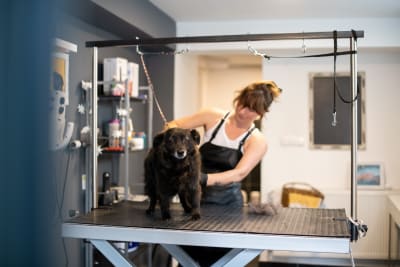Veterinary technicians in Alaska can provide specialized care, assist with diagnosis and surgical procedures, build client relationships, and support when needed. Candidates must spend some time receiving training to become veterinary technicians in Alaska.
However, candidates must follow specific rules concerning training programs and examinations before they can become licensed. These rules can be overwhelming, so we have provided a detailed step-by-step guide below.
We have analyzed the process itself and provided resources concerning specific programs and career outlooks, among other things.
How to Become a Veterinary Technician in Alaska
The steps below are required to become a veterinary technician in Alaska.
Basic Requirements
The fundamental requirements to become a veterinary technician in Alaska include a high school diploma and basic knowledge of natural sciences. Those who don’t have a high school diploma may use a GED equivalent.
Individuals who have volunteered in an animal shelter or rescue facility may also have an edge during admissions and their education.
Completing an Accredited Program
Completing an accredited program is a must for Alaska veterinary technician candidates. This step will help them qualify for the national licensing exam.
It will also allow workers to meet state requirements while developing the necessary skills to thrive.
The Committee on Veterinary Technician Education & Activities (CVTEA) of the American Veterinary Medical Association (AVMA) accredits vet tech programs.
The VTNE
The Veterinary Technician National Examination is a mandatory exam for aspiring veterinary technicians that test their expertise in various critical areas of the profession. It is administered by the American Association of Veterinary State Boards (AAVSB) and requires a $330 examination fee.
Consider exploring careers with similar paths:
Top Veterinary Technician Schools in Alaska
The schools below offer accredited, top-quality training programs for aspiring veterinary technicians in Alaska.
Penn Foster College
Online, AK Online Only
Residents of Alaska may consider the online veterinary technician program offered by Penn Foster College to start their careers. The program is extensive despite being distance-based and even includes an opportunity to receive real-world experience through an externship with partner establishments.
Tuition
$1,599 - $1,999 per SemesterContact
(570) 961-4033
Colby Community College
Colby, KS Online Only
Colby Community College is another institution offering distance-based, accredited veterinary technician training. The program includes 82 credits of instruction in clinical chemistry, veterinary critical care, parasitology, hematology, ophthalmology, and exotic pet medicine, among other subjects.
Tuition
$77 - $162 per CreditContact
(785) 460-5462
vetnursing.assistant@colbycc.edu
Explore nearby states for education and training:
Licensure & Certification Requirements
Candidates in Alaska who have a passing score on the Veterinary Technician National Examination may proceed to receive a license from the Alaska State Board of Veterinary Examiners. However, they still have to meet a few other requirements specified by the board.
The most popular pathway to receiving this license involves submitting a notarized application and three letters of recommendation (two of which must come from licensed veterinarians). Furthermore, applicants must submit proof that they have completed a two-year program in veterinary technology.
Alternatively, they may qualify by showing proof of 2 years of work experience, containing at least 700 hours of real-world duties. At least a year of these must be spent in Alaska.
Lastly, candidates may proceed to submit their form with an application fee and officially receive their license. They must also continually renew this license every 2 years through continuing education.
Salary & Career Outlook
In Alaska, the annual average salary that a veterinary technician takes home at the end of the year will depend on several factors. These factors include experience, credentials, location, and business approach.
Thanks to all these factors, candidates are divided into three broad categories. The first category includes those who are on the favorable side of these factors, earning an annual average salary of $59,395—good enough to put them into the top 10% bracket.
The second category includes less favorable people, earning an annual average salary of $32,484—good enough to be in the bottom 10% bracket. Lastly, those in the median category make around $43,925 in annual average income.
A veterinary technician’s salary in Alaska can also be grouped by location. Palmer and Anchorage are the most notable, with annual average salaries of $48,144 and $43,834, respectively.





